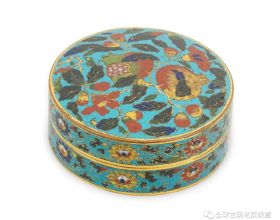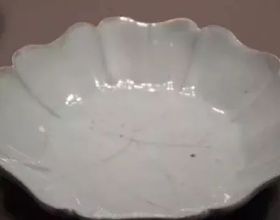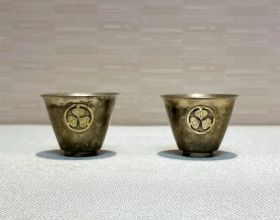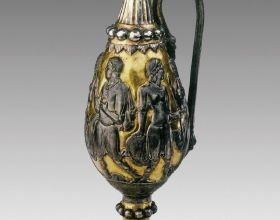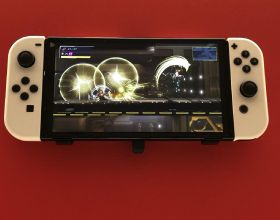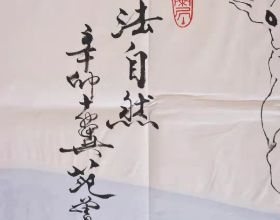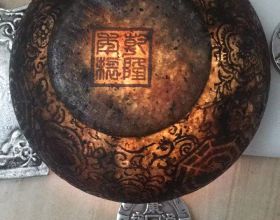烏金釉:瓷器釉色名。始於明代成化年間而以清康熙朝作品為代表。以後衍為古銅、墨褐和鐵棕等。料地有純黑與黑地彩兩種:純黑為一色;黑地彩即在黑地上施彩繪,以黃、綠和紫三色為多。系景德鎮瓷工利用含鐵量達13.4%的烏金土製釉而燒出的一種光潤透亮、色黑如漆的純正黑釉。烏金釉同一般黑釉的區別除鐵成份外,還含有錳、鈷等元素。清代御窯廠生產的烏金釉有黑地白花、黑地描金兩種。烏金釉質地細膩,淨亮如鏡的釉面,為黑釉瓷中難得的佳品。烏金釉是我國名貴的色釉之一,是在建窯,黑定的基礎發展起來的,但與上述各種天目釉的失透現象迥然不同,是一種光潤如黑漆一樣,明亮的黑釉。烏金釉在清康乾年問,極為盛行,並有烏金加赤金及烏金加金圖案開光畫粉彩等綜合裝飾。
烏金釉 它是黑釉中最瑩亮的一種。明代成化年間,景德鎮的藝人在宋代黑釉的基礎上發展烏金釉,但當時燒成極不穩定,也不流行。清代康熙時,烏金釉精製於督陶官臧應選,雍正、乾隆年間,唐英親手參與了工藝製作,仿製了烏金釉等產品。景德鎮傳統烏金釉是用當地產的一種烏金土配製而成,20世紀肋年代以後,景德鎮還採用工業廢料或化工原料生產出非常豔麗的烏金釉,比歷史上的烏金黑度與亮度都有提高。
烏金釉五彩龍紋爐
五爪龍是中國皇帝的標誌,在古代只能由皇帝使用,因此最為尊貴。
周朝有“五爪天子、四爪諸侯、三爪大夫”的說法,清朝開始有“五爪為7龍,四爪為蟒”的說法。元朝以前的龍基本是三爪的,有時前兩足為三爪,後兩足為四爪。明朝流行四爪龍,清朝則是五爪龍為多。
“五爪為龍,四爪為蟒”的說法形成於清代,主要作為皇帝與下臣服裝上紋飾的差別,皇帝穿”龍袍”,其它皇族和下臣穿“蟒袍”,但這只是名稱上的差別而已,從龍的形式上來講無論龍和蟒都是四足蛇類,形狀無差異。
五爪龍實際是實際是五趾不是五爪,金龍是中國皇帝的標誌,在封建社會中規定只能由皇帝使用。而其他皇室人員以及地方需要用到龍形的時候,只能使用“四爪龍”。
此爐為大明宣德年制,烏金釉表面繪製低溫釉燒製,頸部三彩珠點像是鑲嵌的寶石,而執耳,為官帽耳,畫如意靈芝紋,形似如意,與靈芝,畫以枝葉,十分有趣,為如意長壽之意。
可以看到三色火焰紋,形似蝌蚪相聚集,就好似一個個家庭,而三種顏色,也寓意為福祿壽,整個器型為青銅器器型,畫以尊貴的五爪火龍,周身火焰紋環繞,可見其身價不菲。
口緣一圈珠點裝飾,就是起到一個類似寶石點綴的效果,可見邊緣處釉面厚實,毫無脫釉漏胎現象,屬於瓷器之精品。
可以看到三足敦實,其實就是簡化的象腿,從底部來看就像是大象一般圓潤厚實,而古代大象為吉祥之物,結合官帽耳上的如意花卉,意為吉(象)祥如意。
烏金釉以宣德年間為之巔峰,可見此爐採用最鮮豔的三種顏色,紅黃綠,以烏金釉的亮黑為地,對視覺衝突極強,就像是一塊墨玉上,畫上了五彩斑斕的美畫,此三足爐,不僅寓意吉祥,畫面耐賞,而且這五爪龍身價不菲,具有不可估量的收藏價值。
張孝友
1935年生,浙江寧波人,生於上海。幼秉家學,於文史詩畫金石深有造詣。1959年畢業於中央美術學院本科,任教於中央工藝美術學院,現為清華大學美術學院(原中央工藝美院)中國畫教授、中國收藏家協會鑑定專家委員會委員。
八十年代後專攻中國工筆畫,其白描《敦煌禮佛圖卷》等多種作品為國內外廣為流傳,國外多有美術館專藏。其工筆山水、樓閣界畫、人物畫,結構宏大,又精細入微,傳統功力深厚;結合西畫明暗色彩及透視學,融貫中西,自成一家。其代表作《礬樓夜市》多種媒體譽為驚世之作,數十年所罕見。其作品往往積蘊多年,數月方成一畫。主要作品有《吳苑宮觀圖》、《閬苑避暑圖》,山水畫《李白秋浦高會》、《洞仙歌》、人物畫《清平樂》、《八仙過海》及長卷畫《春江花月夜》、《成吉思汗征戰圖卷》(現藏日本某美術館)、《南鄉舊夢》等。
《南鄉舊夢》
此幅《南鄉舊夢圖》是畫家憑兒時記憶所繪的一卷“江南民國風情錄”,其歷史和藝術價值堪比張擇端《清明上河圖》。畫面向我們展示的是百年之前的江南水鄉小鎮超越時空的生活場景,在構圖上取北宋全景式大山大水的佈局特徵,視野開闊清曠,境界宏大,疏密對比強烈。
所繪河道、石磯、樹木、樓閣、市井等等,筆墨均精麗豔逸,骨力峭勁,人物刻畫得生動而富有神采。圖中設色濃麗明雅,勾勒、皴染細密。屋宇樓閣鱗次櫛比,依次排疊,造成了雲氣迷濛的幽遠空間,展現出世俗喧騰而又虛幻飄渺的人間仙境氛圍。畫中人物是主體部分,畫家透過色彩襯托的方法使人物非常突出,充分體現了作者在人物刻畫和景物描繪上精深的藝術功力。
關於《南鄉舊夢》文字說明
最憐夜來憑河窗,天淡如夢月有霜。橋埠百級清似玉,畫船柔櫓出幽港。
餘家江南祖屋,臨街枕河。枇杷門巷。秋桂金馥。軒窗盈翠。讀書之暇可垂釣也。兵燹逋逃,轉遷無定,暫寓西門外。及長,乏見用世之才,系纏碌碌。末業丹青,詩畫浪跡,飄泊萬里,多在湖山僻水之際。餘生亦晚,前清之復亡已二十四年。然嘗及與廢帝遊西山,坐退谷,飲流泉,餘母剝茶蛋食之。時方大饉,相共唏噓默然。又忽忽近五十年矣。生平歷閱盈裡所睹,百年風物,今人不見,旋化虛幻。昔謂狐老蹣跚,猶歸首丘,天涯客思,何況人乎!
《南鄉舊夢圖》描繪的是作者記憶中的兒時江南故鄉的情景,作者以二年之功力完成此長篇大畫,可謂是巔峰之作,需要耗費大量的精力,耗盡兩年的心血而成,是一件不折不扣的傳世之寶,具有不可估量的收藏價值。
英文翻譯:Black gold glaze: name of porcelain glaze. It began in the Chenghua period of Ming Dynasty and was represented by the works of Kangxi Dynasty of Qing Dynasty. Later evolved to bronze, ink brown and iron brown. Material has two kinds of pure black and black color: pure black is one color; Black ground color is painted on the black ground, with yellow, green and purple colors. It is a pure black glaze made by jingdezhen porcelain workers with 13.4% iron content of black gold earth. The difference between wujin glaze and general black glaze is that it contains manganese, cobalt and other elements in addition to iron. The black gold glaze produced by imperial kiln factory in qing Dynasty has two kinds: black ground white flower and black ground tracing gold. Wujin glaze is delicate and bright as a mirror. It is a rare product in black glazed porcelain. Wujin glaze is one of the precious colored glazes in China. It is developed on the basis of kiln construction and black ding. However, it is very different from the above mentioned phenomena of transparency loss of tianmu glaze, and it is a bright black glaze like black paint. Wujin glaze in the Qing Kangqian years, very popular, and wujin plus pure gold and Wujin plus gold pattern light painting pastel and other comprehensive decoration.
Black gold glaze it is one of the most jade-like black glaze. During the Chenghua period of the Ming Dynasty, artists in Jingdezhen developed wujin glaze based on the black glaze of the Song Dynasty, but the firing was extremely unstable and not popular at that time. During the Reign of Emperor Kangxi of the Qing Dynasty, Wujin glaze was refined by Zang Yingxuan, the governor of pottery. During the reign of Emperor Yongzheng and Emperor Qianlong, Tang Ying personally participated in the process and imitated Wujin glaze and other products. Jingdezhen traditional black gold glaze is made of a local black gold soil. After the 20th century, Jingdezhen also uses industrial waste or chemical raw materials to produce very bright black gold glaze, which has improved the blackness and brightness of black gold in history.
Black gold glaze five color dragon pattern furnace
The five-claw dragon is the symbol of The Chinese emperor. In ancient times, it could only be used by the emperor, so it is the most noble.
In the Zhou Dynasty, there was a saying of "the emperor with five claws, the princes with four claws, and the doctor with three claws". In the Qing Dynasty, there was a saying of "the seven dragons with five claws and the python with four claws". Before the Yuan Dynasty, the dragon was basically three-clawed, sometimes the first two legs were three-clawed, and the last two legs were four-clawed. Ming dynasty popular four-claw dragon, qing Dynasty is five-claw dragon.
The saying of "five-claw for dragon, four-claw for python" was formed in the Qing Dynasty, mainly as the difference between the emperor and his subordinates' clothing decoration. The emperor wore "dragon robe", while other royal families and his subordinates wore "python robe", but this is only the difference in name. In terms of the form of the dragon, both the dragon and the python are quadruped snakes with no difference in shape.
Five claw dragon is actually actually five toes, not five claw, gold dragon is the symbol of the Emperor of China, in the feudal society can only be used by the emperor. Other royal and local people who need to use the dragon form can only use the four-claw dragon.
This furnace is the Xuande year of the Ming Dynasty, wujin glaze surface drawing low temperature glaze firing, neck three-color beads like inlaid gemstones, and the ear, for the official hat ear, painting ruyi ganoderma grain, shape like ruyi, and ganoderma, painting with branches and leaves, very interesting, for ruyi longevity.
You can see the tri-color flame pattern, shaped like tadpoles gathered together, like a family, and three colors, also meaning for fu Lu shou, the whole vessel is bronze vessel, painting with the noble five-claw fire dragon, surrounded by flame pattern, it can be seen that its price is not cheap.
The mouth edge of a circle of beads decoration, is to play a similar gem ornament effect, visible at the edge of the thick glaze, no deglaze leakage phenomenon, belongs to the fine porcelain.
From the bottom, it looks like an elephant. The elephant is a lucky thing in ancient times. Combined with ruyi flowers on the ear of the official hat, it means auspicious (elephant).
Sharply glaze in xuande emperor peak, this furnace adopts the most visible bright three colors, red yellow green, with sharply glaze bright black for ground, the visual conflict is extremely strong, like a piece of black jade, drawing on the beauty of the rainbow, the furnace with three legs, not only considered a lucky, picture to admire the resistance, and the dragon with five claws expensive, has inestimable value for collection.
Xiao-you zhang
Born in 1935 in Ningbo, Zhejiang province, Shanghai. Young bingjia, in the epic painting epigraph deep attements. He graduated from the Central Academy of Fine Arts in 1959 and is now a professor of Chinese painting at the Academy of Fine Arts of Tsinghua University (formerly the Central Academy of Fine Arts) and a member of the Expert Committee of The Chinese Collectors Association.
Since the 1980s, he has specialized in Chinese meticulous brushwork, and his brushwork "Dunhuang Buddha Scroll" and other works are widely spread at home and abroad, and many foreign art museums are specially collected. Its meticulous landscape painting, pavilion boundary painting, figure painting, the structure is grand, and subtle, deep traditional skills; Combining the light and dark color and perspective of western painting, blending Chinese and Western, it is its own family. His representative work Fanlou Night Market is praised as a masterpiece by many media and rarely seen in decades. His works are often accumulated for many years, months into a painting. His main works include Wu Yuan Palace View, Levant Summer Vacation, landscape painting Li Bai Qiu Pu Gao Hui, Dong Xian Song, figure painting Qing Ping Music, Eight Immortals Crossing the Sea, and long scroll painting Spring River And Moonlight Night, Genghis Khan's War Atlas (now in an art museum in Japan), Old Dream of Nanxiang, etc.
Old Dreams in the South
This painting "Old Dream of Nanxiang" is a volume of "Jiangnan and Republic of China style record" drawn by the painter based on his childhood memories. Its historical and artistic value is comparable to Zhang Zeduan's "Riverside Scene at Qingming Festival". The picture shows us the life scenes beyond time and space of the water towns in The South of the Yangtze River a hundred years ago. In the composition, we take the layout features of the panoramic mountains and rivers in the Northern Song Dynasty, with a broad vision and a grand boundary and a strong contrast of density.
The painted rivers, rocks, trees, pavilions, markets and so on are all beautiful and elegant in ink, and the characters are vividly depicted and full of vitality. In the picture, strong li Ming ya, outline, texturing dyed fine. Row upon row of houses and pavilions, sequentially stacked, resulting in a misty and secluded space, showing the secular bustle and illusory fairyland atmosphere on earth. The figure is the main part of the painting, the painter through the method of color foil to make the figure is very prominent, fully reflects the author's profound artistic skills in the characterization and scene description.
About the text description of "Old Dreams in Southern Township"
Most pity night by the river window, the day pale like a dream frost moon. Bridge port 100 qing like jade, painting boat soft sculls out of you port.
Yu Jiangnan ancestral house, facing the street pillow river. Loquat Gate Lane. Autumn is golden. Xuan Windows are green. When one can read, one can fish. A case of escaping, shifting temporarily outside the west gate. And long, lack of use of the world, tied around. At the end of the industry danqing, poetry and painting wandering, drifting thousands of miles, more than in the lake and mountain water. The rest of my life is too late. It has been twenty-four years since the death of the former Qing Dynasty. However, taste and waste emperor travel to the Western hills, sit back valley, drink water spring, more than mother peel tea eggs to eat. When the famine, together sigh in silence. It has been nearly fifty years. Life calendar read in the surplus to see, one hundred years of scenery, people do not see, unreal spin. The old fox waddle, still go to the first hill, tianya guest think, how much more people!
"Nanxiang Old Dream Map" depicts the scene in the author's memory of his childhood jiangnan hometown. The author completed this long painting with two years of skill, which can be described as the peak work. It requires a lot of energy and two years of painstaking efforts, and it is an absolute treasure handed down from generation to generation with immeasurable collection value.











